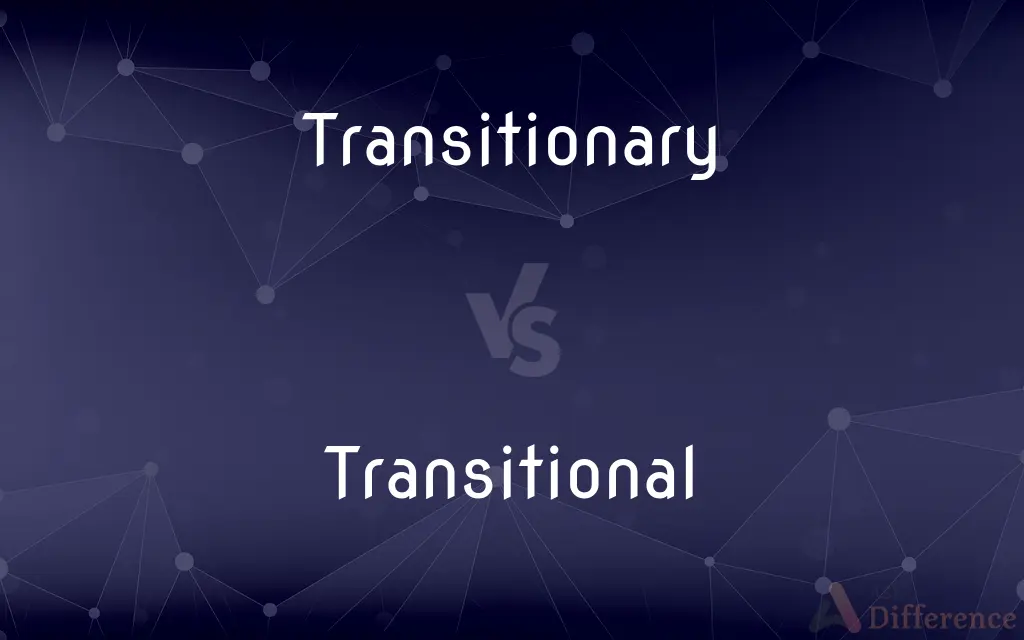Transitionary vs. Transitional — What's the Difference?
By Tayyaba Rehman & Maham Liaqat — Updated on March 20, 2024
Transitionary emphasizes the temporary nature of change, while Transitional focuses on the process of moving from one state to another.

Difference Between Transitionary and Transitional
Table of Contents
ADVERTISEMENT
Key Differences
Transitionary refers to something that exists only for a short period during the process of change, highlighting its temporary and often fleeting nature. It suggests a phase that is not meant to last, serving primarily as a bridge between two states. On the other hand, Transitional focuses more on the process and dynamics of change itself, rather than the duration. It is often used to describe phases that, while not permanent, play a crucial role in development or transformation.
For instance, a transitionary period in a company might involve temporary policies before new, permanent ones are established. Transitional objects in psychology, for example, help children move from dependence to independence, emphasizing the process over the temporality.
While transitionary elements are understood to be brief and not meant for long-term consideration, transitional elements may have a more enduring impact, shaping the development or transformation they are part of. Transitionary phases are expected to pass quickly, whereas transitional phases, despite their impermanent nature, may have lasting effects or importance in the broader process of change.
The term transitionary is less commonly used and has a more specific implication of briefness and temporariness. Transitional, however, is broader and can be applied in various contexts, such as architecture, art, and personal development, indicating a more general state of change or transformation.
While both terms deal with change, transitionary emphasizes the brief nature of a phase within a process, whereas transitional focuses on the significance and mechanics of the change process itself, regardless of the duration.
ADVERTISEMENT
Comparison Chart
Focus
Emphasizes temporariness
Emphasizes the process of change
Usage
Less common, specific to temporary phases
Broad, applicable to various processes of change
Duration
Implicitly brief and fleeting
Can be longer, important for development
Contexts
Often used in organizational or short-term scenarios
Wide-ranging, including psychological, architectural
Implication
Change is not intended to last
Change is part of a developmental process
Compare with Definitions
Transitionary
Brief.
The transitionary nature of their stay made it difficult to form lasting friendships.
Transitional
Developmental.
Children often have a transitional object that helps them deal with change.
Transitionary
Temporary.
The company's transitionary policy will only last until the merger is complete.
Transitional
Process-oriented.
The transitional phase of the project focuses on integrating new team members.
Transitionary
Intermediate.
The transitionary stage between two major product updates is critical for feedback.
Transitional
Interim.
She served as the transitional CEO during the company's restructuring.
Transitionary
Ephemeral.
The artist's transitionary installations are meant to be enjoyed in the moment.
Transitional
Adaptive.
The curriculum is designed to be transitional, accommodating students' progressing knowledge.
Transitionary
Fleeting.
They enjoyed a transitionary period of peace before the storm resumed.
Transitional
Evolving.
Their relationship is in a transitional state, adapting to new circumstances.
Transitionary
Change from one form, state, style, or place to another.
Transitional
Change from one form, state, style, or place to another.
Transitionary
Change from one subject to another in discourse.
Transitional
Change from one subject to another in discourse.
Transitionary
A word, phrase, sentence, or series of sentences connecting one part of a discourse to another.
Transitional
A word, phrase, sentence, or series of sentences connecting one part of a discourse to another.
Transitionary
Change from one key or tonality to another.
Transitional
Change from one key or tonality to another.
Transitionary
A passage connecting two themes or sections, usually changing to a new key or tonality.
Transitional
A passage connecting two themes or sections, usually changing to a new key or tonality.
Transitionary
(Genetics) A point mutation in which a pyrimidine is replaced by another pyrimidine, or a purine is replaced by another purine.
Transitional
(Genetics) A point mutation in which a pyrimidine is replaced by another pyrimidine, or a purine is replaced by another purine.
Transitionary
(Sports) The process of changing from defense to offense or offense to defense without a stoppage in play, as in basketball or hockey.
Transitional
(Sports) The process of changing from defense to offense or offense to defense without a stoppage in play, as in basketball or hockey.
Transitionary
A period during childbirth that precedes the expulsive phase of labor, characterized by strong uterine contractions and nearly complete cervical dilation.
Transitional
A period during childbirth that precedes the expulsive phase of labor, characterized by strong uterine contractions and nearly complete cervical dilation.
Transitionary
To make a transition.
Transitional
To make a transition.
Transitionary
(Sports) To change from defense to offense or offense to defense without a stoppage in play.
Transitional
(Sports) To change from defense to offense or offense to defense without a stoppage in play.
Transitionary
Transitional.
Transitional
Of, or relating to a transition
Transitionary
Transitional.
Transitional
Temporary; pending the implementation of something new
XHTML 1.0 Transitional
Transitional
Of or pertaining to transition; involving or denoting transition; as, transitional changes; transitional stage.
Common Curiosities
How do transitionary periods affect businesses?
Transitionary periods can introduce temporary policies or states that facilitate adjustment to new conditions or transformations.
What is a transitional phase?
A transitional phase is a stage in a process that focuses on moving from one state to another, emphasizing the dynamics of change.
Is the term transitionary commonly used?
Transitionary is less commonly used and is more specific to describing brief, temporary phases.
Can a relationship be transitional?
Yes, relationships can be in a transitional state, evolving and adapting to new dynamics or phases in life.
Do transitionary workers have the same rights as permanent employees?
This can vary by jurisdiction, but transitionary workers often have different rights or protections compared to permanent staff.
How does transitional architecture differ from other styles?
Transitional architecture blends elements from different periods, emphasizing fluid change and adaptation rather than a fixed style.
What makes a policy transitionary?
A policy is transitionary if it is intended to be temporary, often serving as a bridge to more permanent changes.
How can one manage a transitional period effectively?
Effective management of a transitional period involves clear communication, flexibility, and support for those affected by the changes.
What does transitionary mean?
Transitionary refers to something temporary, existing only for a short period during a change process.
Can something be both transitionary and transitional?
Yes, an object or phase can be both transitionary and transitional if it is temporary but plays a crucial role in the process of change.
Why are transitional objects important in psychology?
Transitional objects help individuals, especially children, navigate changes, aiding in emotional development and independence.
How do transitionary and transitional phases contribute to personal growth?
Both types of phases can foster adaptation, resilience, and a deeper understanding of change, contributing to personal development.
Can a book or movie be described as transitional?
Yes, if it represents a shift in style, theme, or perspective, bridging different eras or concepts.
Are transitional phases always noticeable?
Not always; some transitional phases might be subtle, becoming evident only through the gradual accumulation of changes.
What is the significance of transitionary art?
Transitionary art captures fleeting moments or transitions, often highlighting the impermanence of states or conditions.
Share Your Discovery

Previous Comparison
Luminate vs. Illuminate
Next Comparison
Meet vs. MetAuthor Spotlight
Written by
Tayyaba RehmanTayyaba Rehman is a distinguished writer, currently serving as a primary contributor to askdifference.com. As a researcher in semantics and etymology, Tayyaba's passion for the complexity of languages and their distinctions has found a perfect home on the platform. Tayyaba delves into the intricacies of language, distinguishing between commonly confused words and phrases, thereby providing clarity for readers worldwide.
Co-written by
Maham Liaqat












































